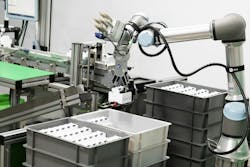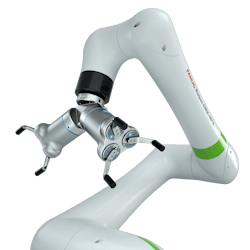Robot End-of-Arm Tooling Interoperability Cuts Costs and Boosts ROI
Why this article is worth reading:
- EOAT interoperability challenges stem from hardware and software differences as mounting profiles, tool sizes and communication protocols vary significantly between robot brands, requiring custom wiring or coding that can increase integration time and costs.
- Standardized EOAT design reduces total cost of ownership. Tools with consistent interfaces and quick-change capabilities can cut deployment time from days to hours while enabling rapid switchovers between applications and robot brands.
- Industry partnerships are driving plug-and-play solutions as major suppliers like OnRobot, Schunk and Robotiq now offer EOAT that integrates across multiple robot platforms while Universal Robots' ecosystem features more than 300 partners and 500 pre-integrated products.
The quest for ever more flexibility from industrial automation tech continues — even extending to robots, the kings of flexible automation. For this reason, demand for greater interoperability between robots and end-of-arm tooling (EOAT) has grown.
The good news is that many EOAT suppliers have responded. “There are many end-effectors on the market today offering interoperability between various kinds of robotic systems,” said Mike DeGrace, OEM solution sales and head of ecosystem success at Universal Robots. “Some examples include tools from suppliers like Schunk, SMC, Festo, Robotiq and OnRobot.
OnRobot, for example, offers EOAT such as grippers, sanders and screwdrivers that integrate with all major robot brands. “We do this through our One System, Zero Complexity concept,” explained James Taylor, chief commercial officer at OnRobot. “It allows our Quick Changer-enabled tools to be exchanged quickly during switchovers between applications or robot brands.”
For more detailed insights into robot EOAT interoperability, we interviewed DeGrace (MD) and Taylor (JT).
AW: What are the common challenges for integrating end-of-arm tooling with different robot-arm interfaces and controllers?
MD: On the hardware side, challenges include the mounting profile from tool to robot flange, the tool size and the fingertip position from the wrist joints of the robot. On the software side, communications present the main challenge. How will the robot interface with the end effector and how will the end-effector be configured in the program? Some brands, such as Universal Robots, give tooling manufacturers the ability to create APIs to simplify configurating end-effectors from the robot’s programming interface. Others require more advanced scripting or even separate controllers to configure specific end-of-arm tools.
JT: There are so many different types of robots and specialized tools that many customers face incredible complexity just trying to get all the components to work together, let alone get them programmed for the application. In many cases, this requires additional wiring or custom coding, which dramatically increases the time and cost needed for integration.
The interoperability of end-of-arm tooling may affect total cost of ownership and ROI of robotic systems, but the results are highly dependent on the application. Some applications require extremely high tool flexibility, while others can take advantage of quick, flexible programming native to some robotic platforms.
Another issue is user experience. If your production team has to relearn how to use a tool every time a different robot is used, you are using valuable time and money. A consistent easy-to-use interface significantly shortens the learning curve, meaning your team spends far less time getting each application up and running.
AW: How does the design of end-of-arm tooling affect its interoperability across various robot brands and models?
JT: There are two main elements to consider for interoperability. The first is the physical attachment of the tool to the robot. This element has both the mechanical and communications component. Many robot brands and models have different types of tool flanges and communication protocols, so it’s important to harmonize the mechanical interface and communication links. The communications component is a common friction point in tooling integration. Each brand of robot has its own way of handling communication, and if a tool isn’t designed to support those differences, integration becomes time-consuming and expensive. Look for tools that are designed to manage these challenges.
MD: The availability of the communication protocols on the robotic platforms being used may affect interoperability. For example, many simple end-effectors may be powered and actuated with discrete I/O, which is available on a wide range of robotic platforms.
JT: Another important element for EOAT interoperability is the user interface for programming the gripper.
MD: An important mechanical standard [related to EOAT interoperability] is the ISO 9409 pattern for the tool-flange connector. (According to ISO, this standard “defines the main dimensions, designation and marking for a circular plate as mechanical interface. It is intended to ensure the exchangeability and to keep the orientation of hand-mounted end effectors.”) Incorporating a hardware and software focused approach to interoperability is critical for creating the most flexible form-factor across robotic systems.
AW: What are the top maintenance or calibration considerations for using EOAT on multiple robots?
MD: There are usually hardware and software considerations. Some may include mounting, cabling and dress-pack management, as well as programming considerations and power management. For example: Is the gripper powered pneumatically or electrically? Other maintenance considerations could be the actual gripping mechanisms, such as the rack and pinion, gears or cylinders. Maintaining stock of some common wear parts is always a good idea.
JT: This is highly variable depending on the type of end-of-arm tooling that you are using, especially if it’s a custom tool. One of the benefits of a standard, out-of-the-box EOAT is that they require less maintenance. Of course, with any mechanical tool, you need to monitor it for the normal wear and tear that happens over long periods of time.
AW: How does end-of-arm tooling interoperability influence the total cost of ownership for robotic systems?
JT: Interoperability reduces costs at every stage. Using a versatile tool that can be programmed consistently and redeployed across applications quickly avoids duplicating investment and engineering work. It also minimizes downtime during changeovers. In many cases, users cut deployment time from days to hours, which dramatically reduces overall costs and improves ROI (return on investment).
If your production team has to relearn how to use a tool every time a different robot is used, you are using valuable time and money. A consistent easy-to-use interface significantly shortens the learning curve, meaning your team spends far less time getting each application up and running.
MD: The interoperability of end-of-arm tooling may affect total cost of ownership and ROI of robotic systems, but the results are highly dependent on the application. Some applications require extremely high tool flexibility, while others can take advantage of quick, flexible programming native to some robotic platforms. There are also manual and automated tool changers which can increase interoperability. So, in some cases, tool interoperability may help with the total cost of ownership and decrease the time for realizing a return.
AW: What advice would you give to manufacturers for selecting interoperable end-of-arm tooling?
MD: Users should carefully consider their applications and their approach to automation before specifying any tooling. There are often many programmatic ways to give them great flexibility. For applications that require frequent tool changes, it is important to consider how these tools will be used and replaced by other tools. For example, will there be a tool changer positioned alongside the robotic platforms?
JT: Users need to look for a tool that is best suited for their applications in terms of specifications. Equally important and often overlooked, though, is looking for a tool that is simple and can be up and running quickly. By simplicity, I mean:
- A quick-and-easy connection to your robot.
- Easy to program and adjust to your production needs. A consistent software interface means operators don’t have to relearn everything when making changes.
- Electric grippers tend to be more convenient when compressed air is not needed.
- Quick tool-changing capability, so you can swap tools in seconds without slowing down production.
AW: What kinds of partnerships or collaborations on interoperability exist between end-of-arm tooling manufacturers and robot builders?
MD: Universal Robots has an ecosystem of partners that have created pre-integrated solutions on the UR platform. These solutions range from simple peripheral devices, such as grippers and vision systems, all the way up to turnkey solutions, such as palletizers and welders. This ecosystem consists of more than 300 partners and 500 products.
JT: We collaborate directly with leading robot manufacturers to ensure seamless integration with each brand. In many cases, these are plug-ins specific to a robot controller.




